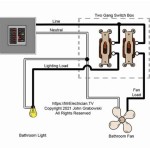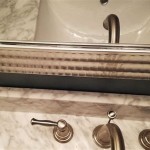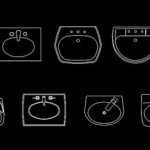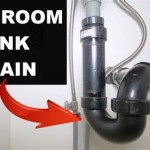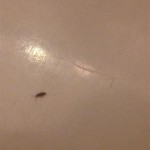Understanding Offset Bathroom Vanity Drainage
The offset bathroom vanity drainage system represents a common plumbing adaptation designed to accommodate spatial constraints and design preferences within bathroom layouts. When a standard, centrally located drain doesn't align with the plumbing rough-in or the chosen vanity design, an offset drain provides a practical solution. This involves strategically shifting the drain location, allowing for greater flexibility in vanity placement and maximizing storage space beneath the sink.
The implementation of an offset drain requires careful planning and execution to ensure proper water flow and prevent potential plumbing issues, such as clogs and leaks. Understanding the components involved, the applicable plumbing codes, and the potential benefits and drawbacks is crucial for a successful installation. This article will explore the intricacies of offset bathroom vanity drainage, offering insights into its functionality, installation considerations, and troubleshooting strategies.
Key Considerations Before Installation
Before embarking on an offset drain installation, several critical factors must be assessed to ensure compatibility and functionality. These considerations encompass plumbing code compliance, space limitations, and the selection of appropriate materials and fittings.
Firstly, adherence to local plumbing codes is paramount. These codes dictate the permissible offset distances, pipe slopes, and material specifications for drainage systems. Failure to comply with these regulations can result in costly rework and potential safety hazards. Consultation with a licensed plumber is highly recommended to ascertain the specific code requirements applicable to the installation location.
Secondly, the available space beneath the vanity must be carefully evaluated. The offset drain configuration will consume a portion of this space, potentially impacting storage capacity. It is essential to measure the dimensions of the vanity cabinet and the existing plumbing rough-in to determine the optimal offset distance and ensure sufficient clearance for the drain components. Furthermore, consider the placement of any shelves or drawers within the vanity to avoid interference with the drain assembly.
Thirdly, the selection of appropriate materials and fittings is crucial for the longevity and reliability of the offset drain system. Typically, PVC or ABS piping is used for drainage applications due to its durability and resistance to corrosion. However, copper or brass may also be employed in certain situations, particularly for exposed drain components. The fittings used to connect the drainpipes should be of high quality and specifically designed for drainage applications. These fittings should be properly sized and installed to prevent leaks and ensure a watertight seal. The use of appropriate primer and cement, as specified by the manufacturer, is essential for creating a secure and durable connection between PVC or ABS pipes and fittings.
Components of an Offset Bathroom Vanity Drain
An offset bathroom vanity drain comprises several key components that work in concert to effectively channel wastewater from the sink to the main drain line. Understanding the function of each component is essential for proper installation and maintenance.
The tailpiece is the initial connection point, extending directly from the sink drain. It is typically made of brass or PVC and connects to the sink strainer. The length of the tailpiece may need to be adjusted depending on the height of the vanity and the location of the drain outlet.
The P-trap is a curved section of pipe designed to trap a small amount of water, creating a barrier that prevents sewer gases from entering the bathroom. It is an essential component of any drain system, as sewer gases can be harmful and unpleasant. The P-trap should be accessible for cleaning and maintenance purposes.
The extension pipe, often referred to as a "waste arm," extends from the P-trap to the wall drain. This pipe is used to create the offset, allowing the drain to connect to the wall drain even if it is not directly aligned with the sink drain. The length and angle of the extension pipe will vary depending on the specific offset required.
Various fittings, such as elbows and couplings, are used to connect the different components of the drain system. These fittings must be properly sized and installed to ensure a watertight seal. The use of appropriate primer and cement is essential for creating a secure connection between PVC or ABS pipes and fittings.
Finally, the escutcheon, or drain flange, is a decorative plate that covers the hole in the wall where the drainpipe exits. It provides a clean and finished look and helps to prevent drafts from entering the bathroom.
Installation Techniques and Best Practices
The installation of an offset bathroom vanity drain requires meticulous attention to detail and adherence to established plumbing practices. Following these techniques and best practices will help ensure a successful and leak-free installation.
Prior to commencing the installation, carefully measure and plan the drain configuration. Determine the required offset distance and select the appropriate components and fittings. Ensure that all materials are readily available and that the necessary tools are on hand.
When cutting the drainpipes, use a pipe cutter or fine-toothed saw to create clean, square cuts. Deburr the edges of the cut pipes to prevent damage to the fittings and ensure a proper seal. Apply primer and cement to the joining surfaces of PVC or ABS pipes and fittings, following the manufacturer's instructions. Insert the pipe firmly into the fitting and hold it in place until the cement has set.
Ensure that the P-trap is properly aligned and that the water seal is maintained. The P-trap should be installed in a position that allows for easy access for cleaning and maintenance. Avoid over-tightening the fittings, as this can damage the pipes and create leaks. Use Teflon tape or pipe dope on threaded connections to ensure a watertight seal.
After completing the installation, thoroughly test the drain system for leaks. Run water into the sink and check all connections for any signs of leakage. If leaks are detected, tighten the fittings or replace the damaged components as necessary. Ensure that the drain flows freely and that there are no obstructions in the pipes. A slow drain can indicate a blockage or improper slope.
Proper slope is vital for efficient drainage. Plumbing codes typically specify a minimum slope of 1/4 inch per foot for drain lines. This ensures that wastewater flows smoothly and prevents the buildup of sediment and debris. Use a level to check the slope of the drain lines and make adjustments as necessary.
Consider using flexible drain connectors in situations where precise alignment is difficult to achieve. Flexible connectors can accommodate slight misalignments and make the installation process easier. However, it is important to use high-quality flexible connectors that are specifically designed for drainage applications.
Troubleshooting Common Issues
Even with careful installation, issues can sometimes arise with offset bathroom vanity drains. Understanding common problems and their solutions can save time and prevent costly repairs.
Leaks are among the most frequent problems encountered with drain systems. Leaks can occur at the connections between pipes and fittings, or they can be caused by damaged or worn-out components. To troubleshoot a leak, carefully inspect all connections for any signs of water. Tighten the fittings or replace the damaged components as necessary. If the leak persists, consider using Teflon tape or pipe dope on threaded connections.
Clogs are another common issue. Clogs can be caused by hair, soap scum, or other debris that accumulates in the drainpipes. To clear a clog, try using a plunger. If the plunger is not effective, use a drain snake or auger to break up the clog. In severe cases, it may be necessary to disassemble the drain system to remove the clog manually.
Slow drainage can indicate a partial blockage or an insufficient slope. Check the drainpipes for obstructions and ensure that the slope is at least 1/4 inch per foot. If the slope is inadequate, it may be necessary to reconfigure the drain system to achieve the proper pitch. Also, ensure that the vent stack is clear, as a blocked vent can impede drainage.
Sewer gas odors can be a sign of a dry P-trap or a damaged drainpipe. The P-trap should always contain water to prevent sewer gases from entering the bathroom. If the P-trap is dry, add water to it. If the odors persist, inspect the drainpipes for cracks or leaks. Replace any damaged pipes or fittings as necessary.
Noisy drains can be caused by air pockets or water hammer. Air pockets can create gurgling sounds as water flows through the drainpipes. Water hammer is a sudden pressure surge that occurs when a faucet is turned off quickly. To address noisy drains, install air chambers or water hammer arrestors in the plumbing system.
Regular maintenance, such as flushing the drain with hot water and baking soda, can help prevent clogs and maintain the smooth operation of the drain system. Avoid pouring grease or other oily substances down the drain, as these can contribute to clogs.

Uln671 Master Plumber 1 4 Offset Grid Strainer Bathroom Sink Drain Chrome Amre Supply

Uln671 Master Plumber 1 4 Offset Grid Strainer Bathroom Sink Drain Chrome Amre Supply

Eastman 1 4 In 17 Gauge Offset Lavatory Drain Chrome 35078 The Home Depot

Uln671 Master Plumber 1 4 Offset Grid Strainer Bathroom Sink Drain Chrome Amre Supply

W 36 White Bathroom Vanity Cabinet And Ceramic Vessel Sink Equipped With Chrome Faucet Drain Mirror Vanities Set Com

Eclife 24 W X 20 D 32 H Classical Bathroom Vanity Vessel Sink Set With Chrome Faucet And Mirror Mdf Black White Ceramic Rectangle Solid Brass Pop Up Drain Combo

Bathroom Vanities With Offset Sinks A Simple Way To Avoid Big Renovation

Ariel Cambridge 43 In Grey Left Offset Single Sink Bathroom Vanity With Carrera White Natural Marble Top Réno Dépôt

Willow Collections Hudson 36 In W X 22 D H Right Offset Sink Bath Vanity Black With 2 Piatra Quartz Top Abd Blk Pt Gr 36r The Home Depot

Ariel Taylor 37 In White Undermount Single Sink Bathroom Vanity With Quartz Top The Vanities Tops Department At Com
Related Posts
